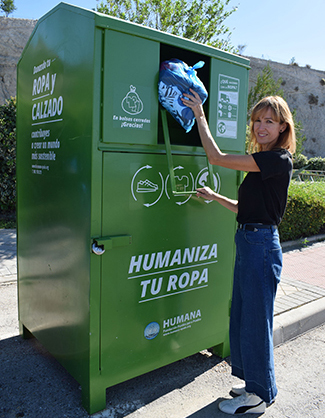consent_cookie
Duración: 1 year
Stores the user's cookie consent state
04-06-2020
The textile industry is responsible for 10% of the planet's emissions, according to the World Bank. And the second that demands more water resources. The number of times we wear a garment before we dispose of it has decreased 36% in the last 15 years. Every year 100,000 million garments are sold throughout the planet.
It seems clear, therefore, that in order to promote environmental protection, it is necessary that consumers, brands, manufacturers and societies around the world promote a more sustainable model. Tomorrow, June 5, World Environment Day is celebrated. Excellent time to insist on all this.
Both the Foundation and the rest of the Humana People to People organizations have been working for decades to promote the reuse of clothing and footwear, thereby reducing the impact of the industry and turning a used object into a resource to help those who they need it the most.
Reducing emissions and fighting the consequences of climate change
Last year, Humana managed to collect in Europe and the United States about 150,000 tons of clothing and footwear. An average of 9 out of 10 garments had a second life through reuse or recycling. According to the European Commission, for every kilo of clothing recovered and not taken to a landfill for incineration or final disposal, 3,169 kg of CO2 are no longer emitted. Therefore, Humana's work allowed to stop emitting 465,000 tons of CO2 just last year. In other words, reuse has a direct and very positive effect in the fight against the consequences of climate change.
Significant savings on the natural resources that the fashion industry requires
Acquiring second-hand clothes avoids the annual consumption of millions of new garments, which translates into significant savings in the natural resources that the fashion industry requires. Six out of ten users affirm that when buying a garment in the Foundation's establishments, they do not need to acquire it in another conventional point of sale, according to a survey carried out among 900 clients in Madrid and Barcelona. This replacement rate confirms the environmental value of reuse. Because there is no more sustainable garment than the one already manufactured.
In Spain alone, Humana stores registered in 2019, 1.9 million customers, who purchased more than 5.2 million items. This implies that, as a minimum, the commitment to reuse last year avoided the consumption of 3.12 million new items, taking into account that 60% replacement rate. Globally, more than 10.7 million people shopped last year at Humana's 508 second-hand points of sale in Europe and the United States. This indicates, making a projection, that the reuse avoided the consumption in 2019 of 17.5 million garments.
.jpg)
